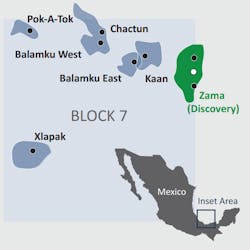Talos Energy ramps up its E&P activities in US, Mexican Gulf
Talos Energy Inc. says that it has entered into two separate agreements with BP and ExxonMobil related to new exploration opportunities in the US Gulf of Mexico. Talos says it will work with BP to drill and evaluate the Puma West prospect, located in Talos-owned Green Canyon block 821, in 4Q 2019.
On the Puma West opportunity, Talos will retain a 25% working interest, with BP, as operator, holding the remaining working interest. The initial exploration well is expected to be spud before the end of October 2019 using the Seadrill West Auriga ultra-deepwater drillship. The prospect consists of subsalt, Miocene target zones believed to be similar to the prolific Mad Dog field located less than 15 mi from the proposed well location. The original Mad Dog spar has produced over 230 MMboe since inception, and BP is currently constructing the Argos platform for the Mad Dog II project, which will add 140,000 b/d of oil of additional production capacity to the field. The Puma West prospect was identified and permitted by Talos following a significant seismic reprocessing effort in the company’s Green Canyon core area.
Under a separate agreement with ExxonMobil, Talos has acquired a 100% working interest in the Hershey prospect from ExxonMobil and will become designated operator of Green Canyon blocks 326, 327, 370, and 371, which constitute approximately 23,000 gross acres. Hershey is a large, subsalt Miocene prospect with potential for several stacked horizons. Based on preliminary estimates, Talos believes that the prospect may contain oil-weighted, gross unrisked resources of 100-300 MMboe if successful. Hershey could be developed as a subsea tieback to multiple Talos-controlled Green Canyon facilities or with new, dedicated infrastructure.
Meanwhile, offshore Mexico, Talos Energy says it has secured a two-year extension to block 7 in the offshore Sureste basin from Mexico’s National Hydrocarbons Commission (CNH).
In addition, the commission approved additional exploration activities on the block, which Talos operates in partnership with Premier Oil and Wintershall DEA subsidiary Sierra Oil & Gas.
Aside from the appraised Zama field, the consortium has identified various targets such as Xlapak and Pok-A-Tok prospects, each with estimated resources in the range 75-150 MMboe.
These are amplitude-supported oil prospects in sands of similar age to those tested in the Zama wells, and they are also close enough to Zama to allow for development cost synergies, if successful.
The original block 7 production-sharing contract required the consortium to relinquish around half the acreage upon obtaining a two-year term extension; however, the modified exploration plan, approved by CNH, allows for retention of the acreage covering all the potential exploration targets.
In the meantime, discussions continue with Pemex on unitization of the Zama field, which extends into an adjoining block. Talos says that front-end engineering and design is advancing ahead of a planned final investment decision in 2020.
New website details history of Shell’s Mars project
A new multi-media website has been developed that documents and narrates the story of Royal Dutch Shell’s pioneering development of the Mars basin in the deepwater Gulf of Mexico, in 3,000 ft of water.
Developed by energy and environment historian Tyler Priest, the website can be found at https://dsps.lib.uiowa.edu/mars-deepwater-gulf/. Priest focused on the history of Shell’s E&P activities in the US Gulf of Mexico in his book, The Offshore Imperative: Shell Oil’s Search for Petroleum in the Postwar United States, which was published by Texas A&M University Press in 2007.
Priest says that the story of deepwater oil E&P in the Gulf of Mexico can be told through the story of Mars, historically the largest single source of crude oil in American waters. It was one of the earliest prospects to be drilled and developed on some of the first federal deepwater leases offered in the early 1980s. In the late 2010s, 35 years later, it remains one of the most productive basins in the Gulf at the cutting edge of technology.
By reviewing the history of the Mars project, the website documents the wide-ranging innovations that have propelled the industry into ever-deeper waters and new geological frontiers. The history of the Mars project provides a window into the evolution of geophysical technology and interpretation; drilling and well completion; platform and facilities design; subsea and reservoir engineering; and project and safety management.
The Mars facility also played a key role in the industry’s recovery from two traumatic disasters, Hurricane Katrina in 2005 and the Macondo oil spill in 2010; this too is documented on the website. Finally, the 2014 installation of a second, state-of-the-art facility, Olympus, in the same field once again placed Mars in the forefront of offshore development.
The website also provides a forum for “Martians” and other participants to contribute their recollections, images, or artifacts which will help to maintain the living history and memory of “Shell Oil’s Deepwater Mission to Mars.” •




